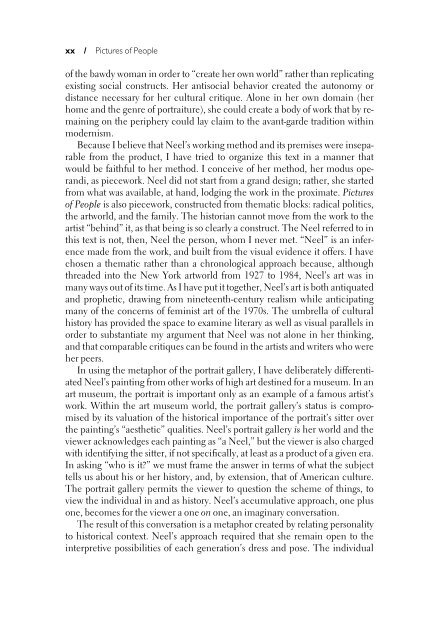i-xxii Front matter.qxd - Brandeis Institutional Repository
i-xxii Front matter.qxd - Brandeis Institutional Repository
i-xxii Front matter.qxd - Brandeis Institutional Repository
Create successful ePaper yourself
Turn your PDF publications into a flip-book with our unique Google optimized e-Paper software.
xx / Pictures of Peopleof the bawdy woman in order to “create her own world” rather than replicatingexisting social constructs. Her antisocial behavior created the autonomy ordistance necessary for her cultural critique. Alone in her own domain (herhome and the genre of portraiture), she could create a body of work that by remainingon the periphery could lay claim to the avant-garde tradition withinmodernism.Because I believe that Neel’s working method and its premises were inseparablefrom the product, I have tried to organize this text in a manner thatwould be faithful to her method. I conceive of her method, her modus operandi,as piecework. Neel did not start from a grand design; rather, she startedfrom what was available, at hand, lodging the work in the proximate. Picturesof People is also piecework, constructed from thematic blocks: radical politics,the artworld, and the family. The historian cannot move from the work to theartist “behind” it, as that being is so clearly a construct. The Neel referred to inthis text is not, then, Neel the person, whom I never met. “Neel” is an inferencemade from the work, and built from the visual evidence it offers. I havechosen a thematic rather than a chronological approach because, althoughthreaded into the New York artworld from 1927 to 1984, Neel’s art was inmany ways out of its time. As I have put it together, Neel’s art is both antiquatedand prophetic, drawing from nineteenth-century realism while anticipatingmany of the concerns of feminist art of the 1970s. The umbrella of culturalhistory has provided the space to examine literary as well as visual parallels inorder to substantiate my argument that Neel was not alone in her thinking,and that comparable critiques can be found in the artists and writers who wereher peers.In using the metaphor of the portrait gallery, I have deliberately differentiatedNeel’s painting from other works of high art destined for a museum. In anart museum, the portrait is important only as an example of a famous artist’swork. Within the art museum world, the portrait gallery’s status is compromisedby its valuation of the historical importance of the portrait’s sitter overthe painting’s “aesthetic” qualities. Neel’s portrait gallery is her world and theviewer acknowledges each painting as “a Neel,” but the viewer is also chargedwith identifying the sitter, if not speciƒcally, at least as a product of a given era.In asking “who is it?” we must frame the answer in terms of what the subjecttells us about his or her history, and, by extension, that of American culture.The portrait gallery permits the viewer to question the scheme of things, toview the individual in and as history. Neel’s accumulative approach, one plusone, becomes for the viewer a one on one, an imaginary conversation.The result of this conversation is a metaphor created by relating personalityto historical context. Neel’s approach required that she remain open to theinterpretive possibilities of each generation’s dress and pose. The individual
















